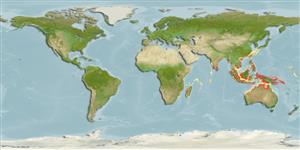Lauridromia indica (Gray, 1831)
Cannonball sponge crab| Native range | All suitable habitat | Point map | Year 2050 |

|
| This map was computer-generated and has not yet been reviewed. |
| Lauridromia indica AquaMaps Data sources: GBIF OBIS |
Upload your photos
Google image | No image available for this species;
drawing shows typical species in Dromiidae.
Google image | No image available for this species;
drawing shows typical species in Dromiidae.
Classification / Names Common names | Synonyms | CoL | ITIS | WoRMS
Malacostraca | Decapoda | Dromiidae
Environment: milieu / climate zone / depth range / distribution range Ecology
Benthic; depth range 7 - 90 m (Ref. 3175). Tropical
Distribution Countries | FAO areas | Ecosystems | Occurrences | Introductions
Indo-West Pacific.
Length at first maturity / Size / Weight / Age
Maturity: Lm ? range ? - ? cm Max length : 8.3 cm CW male/unsexed; (Ref. 343); 7 cm CW (female)
Short description Morphology
Carapace rounded, much wider than long; surface convex, with dense pubescence; 6 anterolateral teeth. Spine present on outer margin of dactylus of last walking leg. Light brown with bright pink fingers.
Maximum size of male from Ref. 3175. Omnivorous, feeds on sea stars (Asteroidea). Carries sponges and colonial tunicates on back for camouflage (Ref. 343).
Life cycle and mating behavior Maturity | Reproduction | Spawning | Eggs | Fecundity | Larvae
Members of the order Decapoda are mostly gonochoric. Mating behavior: Precopulatory courtship ritual is common (through olfactory and tactile cues); usually indirect sperm transfer.
Main reference
References | Coordinator | Collaborators
Ng, P.K.L. 1998. (Ref. 343)
IUCN Red List Status (Ref. 130435)
CITES status (Ref. 108899)
Not Evaluated
CMS (Ref. 116361)
Not Evaluated
Threat to humans
Harmless
Human uses
Fisheries: minor commercial
| FishSource |
Tools
More information
Internet sources
BHL | BOLD Systems | CISTI | DiscoverLife | FAO(Publication : search) | Fishipedia | GenBank (genome, nucleotide) | GloBI | Gomexsi | Google Books | Google Scholar | Google | PubMed | Tree of Life | Wikipedia (Go, Search) | Zoological Record
Estimates based on models
Preferred temperature
(Ref. 115969): 26.1 - 29.1, mean 28.2 (based on 1406 cells).
Price category
(Ref. 80766):
Unknown.



